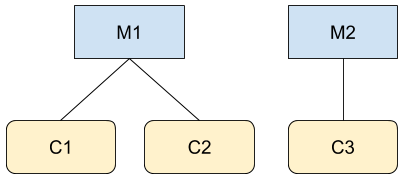Vous pouvez lister les clients auxquels vous avez accès avec la méthode ListAccessibleCustomers dans CustomerService. Toutefois, il est nécessaire de comprendre quels clients sont renvoyés dans ce type de demande.
Lister les clients accessibles est l'une des rares requêtes de l'API Google Ads qui ne nécessite pas de spécifier un numéro client dans la requête. De plus, la requête ignore tout login-customer-id fourni.
La liste de clients qui s'affiche est basée sur vos identifiants OAuth. La requête renvoie la liste de tous les comptes sur lesquels vous pouvez agir directement avec vos identifiants actuels. Cela n'inclut pas nécessairement tous les comptes de la hiérarchie, mais uniquement ceux auxquels votre utilisateur authentifié a été ajouté avec des droits d'administrateur ou d'autres droits.

Imaginez que vous êtes l'utilisateur A, administrateur de M1 et C3 dans les deux hiérarchies illustrées. Si vous deviez appeler l'API Google Ads, par exemple pour GoogleAdsService, vous pourriez accéder aux informations des comptes M1, C1, C2 et C3. Toutefois, un appel à CustomerService.ListAccessibleCustomers ne renverrait que M1 et C3, car ce sont les seuls comptes auxquels l'utilisateur A a un accès direct.
Voici un exemple de code illustrant l'utilisation de la méthode CustomerService.ListAccessibleCustomers :
Java
private void runExample(GoogleAdsClient client) { // Optional: Change credentials to use a different refresh token, to retrieve customers // available for a specific user. // // UserCredentials credentials = // UserCredentials.newBuilder() // .setClientId("INSERT_OAUTH_CLIENT_ID") // .setClientSecret("INSERT_OAUTH_CLIENT_SECRET") // .setRefreshToken("INSERT_REFRESH_TOKEN") // .build(); // // client = client.toBuilder().setCredentials(credentials).build(); try (CustomerServiceClient customerService = client.getLatestVersion().createCustomerServiceClient()) { ListAccessibleCustomersResponse response = customerService.listAccessibleCustomers( ListAccessibleCustomersRequest.newBuilder().build()); System.out.printf("Total results: %d%n", response.getResourceNamesCount()); for (String customerResourceName : response.getResourceNamesList()) { System.out.printf("Customer resource name: %s%n", customerResourceName); } } }
C#
public void Run(GoogleAdsClient client) { // Get the CustomerService. CustomerServiceClient customerService = client.GetService(Services.V22.CustomerService); try { // Retrieve the list of customer resources. string[] customerResourceNames = customerService.ListAccessibleCustomers(); // Display the result. foreach (string customerResourceName in customerResourceNames) { Console.WriteLine( $"Found customer with resource name = '{customerResourceName}'."); } } catch (GoogleAdsException e) { Console.WriteLine("Failure:"); Console.WriteLine($"Message: {e.Message}"); Console.WriteLine($"Failure: {e.Failure}"); Console.WriteLine($"Request ID: {e.RequestId}"); throw; } }
PHP
public static function runExample(GoogleAdsClient $googleAdsClient) { $customerServiceClient = $googleAdsClient->getCustomerServiceClient(); // Issues a request for listing all accessible customers. $accessibleCustomers = $customerServiceClient->listAccessibleCustomers(new ListAccessibleCustomersRequest()); print 'Total results: ' . count($accessibleCustomers->getResourceNames()) . PHP_EOL; // Iterates over all accessible customers' resource names and prints them. foreach ($accessibleCustomers->getResourceNames() as $resourceName) { /** @var string $resourceName */ printf("Customer resource name: '%s'%s", $resourceName, PHP_EOL); } }
Python
def main(client: GoogleAdsClient) -> None: customer_service: CustomerServiceClient = client.get_service( "CustomerService" ) accessible_customers: ListAccessibleCustomersResponse = ( customer_service.list_accessible_customers() ) result_total: int = len(accessible_customers.resource_names) print(f"Total results: {result_total}") resource_names: List[str] = accessible_customers.resource_names for resource_name in resource_names: # resource_name is implicitly str print(f'Customer resource name: "{resource_name}"')
Ruby
def list_accessible_customers() # GoogleAdsClient will read a config file from # ENV['HOME']/google_ads_config.rb when called without parameters client = Google::Ads::GoogleAds::GoogleAdsClient.new accessible_customers = client.service.customer.list_accessible_customers().resource_names accessible_customers.each do |resource_name| puts "Customer resource name: #{resource_name}" end end
Perl
sub list_accessible_customers { my ($api_client) = @_; my $list_accessible_customers_response = $api_client->CustomerService()->list_accessible_customers(); printf "Total results: %d.\n", scalar @{$list_accessible_customers_response->{resourceNames}}; foreach my $resource_name (@{$list_accessible_customers_response->{resourceNames}}) { printf "Customer resource name: '%s'.\n", $resource_name; } return 1; }
curl
# Returns the resource names of customers directly accessible by the user # authenticating the call. # # Variables: # API_VERSION, # DEVELOPER_TOKEN, # OAUTH2_ACCESS_TOKEN: # See https://developers.google.com/google-ads/api/rest/auth#request_headers # for details. # curl -f --request GET \ "https://googleads.googleapis.com/v${API_VERSION}/customers:listAccessibleCustomers" \ --header "Content-Type: application/json" \ --header "developer-token: ${DEVELOPER_TOKEN}" \ --header "Authorization: Bearer ${OAUTH2_ACCESS_TOKEN}" \
Lister les comptes résiliés
L'API Google Ads ne permet pas de lister directement les comptes clôturés sous un compte administrateur. Toutefois, vous pouvez utiliser la solution de contournement suivante pour récupérer cette liste.
Récupérez la liste des liens
ACTIVEà l'aide de la ressourcecustomer_client_linket créez une liste de clients à l'aide du champcustomer_client_link.client_customer.SELECT customer_client_link.client_customer, customer_client_link.status FROM customer_client_link WHERE customer_client_link.status = ACTIVERécupérez la liste des comptes
ENABLEDà l'aide de la ressourcecustomer_client.SELECT customer_client.id, customer_client.descriptive_name FROM customer_clientLa différence entre les deux listes vous donne la liste des comptes résiliés.

